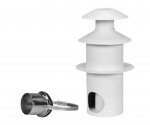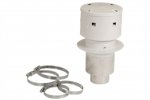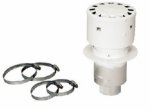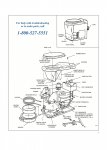biotect
Designer
.
CONTINUED FROM PREVIOUS POST
********************************************
12. Conclusion
********************************************
In short, the Cinderella sounds like the real deal: an incinerating toilet that won't stink up the interior of a motorhome.
As for the outside, I am not sure. In answer to an FAQ in the "Cinderella Motion" PDF about smell outside the motorhome (page 26), Cinderella writes that there should not be any. But if there is, one should switch to or install a "bundled winter chimney" on the roof of the motorhome:
This is not a Google translation; it is the English as it appears in a multilingual PDF. I tried looking up "bundled winter chimney" a variety of ways, but came up short. If anyone knows what this is, please post! Keeping exterior smell to a minimum will also be important, so it would be good to have a concrete visual image of the kind of chimney that Cinderella is talking about.
The Cinderella's mechanical complexity may give one pause for thought. But I figure that's the price one has to pay for the big plate that closes and seals off the combustion chamber, so that the Cinderella does not smell. The Incinolet may be mechanically much simpler, but nobody in their right mind would ever install the Incinolet in a motorhome.
Presumably the Cinderella "Motion"/”Cabby Loo” designed for use in motorhomes has been further finessed to handle the constant vibration of road travel. It seems to be relatively new; for instance, the Danish review dates to 2013. But presumably by 2020 the design will have been perfected, in part refined via lots of customer feed-back. Cinderella toilets more generally, of the kind used in fixed homes and cottages, have been around for a while. I read somewhere (I can no longer find the reference) that about 3 % of Swedish and Norwegian households now have them. There are about 6,526,000 households in the two countries combined, so 3 % of that would be 195,773, or almost 200,000 Cinderella toilets installed -- see http://www.scb.se/en_/Finding-stati...ktuell-Pong/25795/Behallare-for-Press/367855/ , https://www.ssb.no/en/befolkning/statistikker/familie/aar/2014-12-12 , and https://en.wikipedia.org/wiki/List_of_countries_by_number_of_households . However, elsewhere I've read that the figure is more like 30,000 - 40,000 Cinderellas installed. Either way, Cinderella's patented design dates back to 1997, and only the "Motion" or "Cabby Loo" version designed specifically for use in a motorhome is a bit new.
Needless to say, all RV toilets involve some degree of hassle and worry. Vacuum toilets that provide a "flush and forget" experience and empty into a blackwater tank seem great at first, until one needs to empty the blackwater tank, and
clean and maintain it. The hassle and questionable aesthetics of composting toilets are self-evident. And Earthroamer's small cassettes must be emptied every 2 - 3 days (one cassette), or every 4 - 6 days (two cassettes). Which means they are not exactly hassle-free either.
The Cinderellla does need occasional maintenance, which means that about once a year, or every 1000 incinerations (two packs of bags), the catalyst and ventilation pipes should be cleaned:
A simpler and less hassle-free toilet-cleaning procedure than rinsing the Cinderella's catalyst could not be imagined. The second video shows other procedures to be performed once-every-1000 incinerations, for instance, cleaning the ash-bowl gently with water, and cleaning the ventilation pipes. In all of these procedures there is no need to wear gloves, because all the pathogens are dead, and one touches only accumulated lifeless ash.
The ash-tray needs to emptied once every 70 visits:
It is "normal" and perfectly healthy to poop three times a day, and so too it's within the range of "normality" to poop once every three days. The possible healthy variation here is wide -- see http://www.umass.edu/mycenter/documents/bb/poop.pdf and http://health.usnews.com/health-new...often-should-i-poop-and-other-toilet-topics/3 . But let's work with one poop per person per day, which means that if two people use the TerraLiner, then the Cinderella's ash-tray would only have to be emptied about once every 35 days. Or a bit more than once a month, which is terrific from the point of view of extended boondocking. And when emptying the Cinderella's ash-tray, again one handles only pathogen-free ash, ash that can be dumped just about anywhere, without harmful environmental consequences. So there will be no need to pack up the TerraLiner and de-camp just to find somewhere to dispose of accumulated sewage in the blackwater tank. 6 months staying put in just one spot becomes a real possibility, unconstrained by the production of human waste.
Other incinerating options would certainly be worth investigating, for instance, EcoJohn with its “auger”. But somehow I doubt that any other incinerating toilets have been designed with as much attention to detail and engineering as the Cinderella. And as near as I can tell, the Cinderella is the only incinerating toilet that is now being actively sold in the motorhome market. Sure, some Incinolets have been installed in motorhomes, but their owners soon regretted having done so, because the Incinolet smells like the Apocalypse during its burn cycle.....:sombrero:
All best wishes,
Biotect
CONTINUED FROM PREVIOUS POST
********************************************
12. Conclusion
********************************************
In short, the Cinderella sounds like the real deal: an incinerating toilet that won't stink up the interior of a motorhome.
As for the outside, I am not sure. In answer to an FAQ in the "Cinderella Motion" PDF about smell outside the motorhome (page 26), Cinderella writes that there should not be any. But if there is, one should switch to or install a "bundled winter chimney" on the roof of the motorhome:
Can it smell outside?
On cold toilets and during special weather conditions you may experience a little burning smell on the outside of the caravan at the start of combustion. If this is perceived as problematic, you can switch to the bundled winter chimney on the roof of the carriage. It is also recommended to clean the ash tray and rinse the catalyst if this should happen.
This is not a Google translation; it is the English as it appears in a multilingual PDF. I tried looking up "bundled winter chimney" a variety of ways, but came up short. If anyone knows what this is, please post! Keeping exterior smell to a minimum will also be important, so it would be good to have a concrete visual image of the kind of chimney that Cinderella is talking about.
The Cinderella's mechanical complexity may give one pause for thought. But I figure that's the price one has to pay for the big plate that closes and seals off the combustion chamber, so that the Cinderella does not smell. The Incinolet may be mechanically much simpler, but nobody in their right mind would ever install the Incinolet in a motorhome.
Presumably the Cinderella "Motion"/”Cabby Loo” designed for use in motorhomes has been further finessed to handle the constant vibration of road travel. It seems to be relatively new; for instance, the Danish review dates to 2013. But presumably by 2020 the design will have been perfected, in part refined via lots of customer feed-back. Cinderella toilets more generally, of the kind used in fixed homes and cottages, have been around for a while. I read somewhere (I can no longer find the reference) that about 3 % of Swedish and Norwegian households now have them. There are about 6,526,000 households in the two countries combined, so 3 % of that would be 195,773, or almost 200,000 Cinderella toilets installed -- see http://www.scb.se/en_/Finding-stati...ktuell-Pong/25795/Behallare-for-Press/367855/ , https://www.ssb.no/en/befolkning/statistikker/familie/aar/2014-12-12 , and https://en.wikipedia.org/wiki/List_of_countries_by_number_of_households . However, elsewhere I've read that the figure is more like 30,000 - 40,000 Cinderellas installed. Either way, Cinderella's patented design dates back to 1997, and only the "Motion" or "Cabby Loo" version designed specifically for use in a motorhome is a bit new.
Needless to say, all RV toilets involve some degree of hassle and worry. Vacuum toilets that provide a "flush and forget" experience and empty into a blackwater tank seem great at first, until one needs to empty the blackwater tank, and
clean and maintain it. The hassle and questionable aesthetics of composting toilets are self-evident. And Earthroamer's small cassettes must be emptied every 2 - 3 days (one cassette), or every 4 - 6 days (two cassettes). Which means they are not exactly hassle-free either.
The Cinderellla does need occasional maintenance, which means that about once a year, or every 1000 incinerations (two packs of bags), the catalyst and ventilation pipes should be cleaned:
A simpler and less hassle-free toilet-cleaning procedure than rinsing the Cinderella's catalyst could not be imagined. The second video shows other procedures to be performed once-every-1000 incinerations, for instance, cleaning the ash-bowl gently with water, and cleaning the ventilation pipes. In all of these procedures there is no need to wear gloves, because all the pathogens are dead, and one touches only accumulated lifeless ash.
The ash-tray needs to emptied once every 70 visits:
It is "normal" and perfectly healthy to poop three times a day, and so too it's within the range of "normality" to poop once every three days. The possible healthy variation here is wide -- see http://www.umass.edu/mycenter/documents/bb/poop.pdf and http://health.usnews.com/health-new...often-should-i-poop-and-other-toilet-topics/3 . But let's work with one poop per person per day, which means that if two people use the TerraLiner, then the Cinderella's ash-tray would only have to be emptied about once every 35 days. Or a bit more than once a month, which is terrific from the point of view of extended boondocking. And when emptying the Cinderella's ash-tray, again one handles only pathogen-free ash, ash that can be dumped just about anywhere, without harmful environmental consequences. So there will be no need to pack up the TerraLiner and de-camp just to find somewhere to dispose of accumulated sewage in the blackwater tank. 6 months staying put in just one spot becomes a real possibility, unconstrained by the production of human waste.
Other incinerating options would certainly be worth investigating, for instance, EcoJohn with its “auger”. But somehow I doubt that any other incinerating toilets have been designed with as much attention to detail and engineering as the Cinderella. And as near as I can tell, the Cinderella is the only incinerating toilet that is now being actively sold in the motorhome market. Sure, some Incinolets have been installed in motorhomes, but their owners soon regretted having done so, because the Incinolet smells like the Apocalypse during its burn cycle.....:sombrero:
All best wishes,
Biotect
Last edited:












